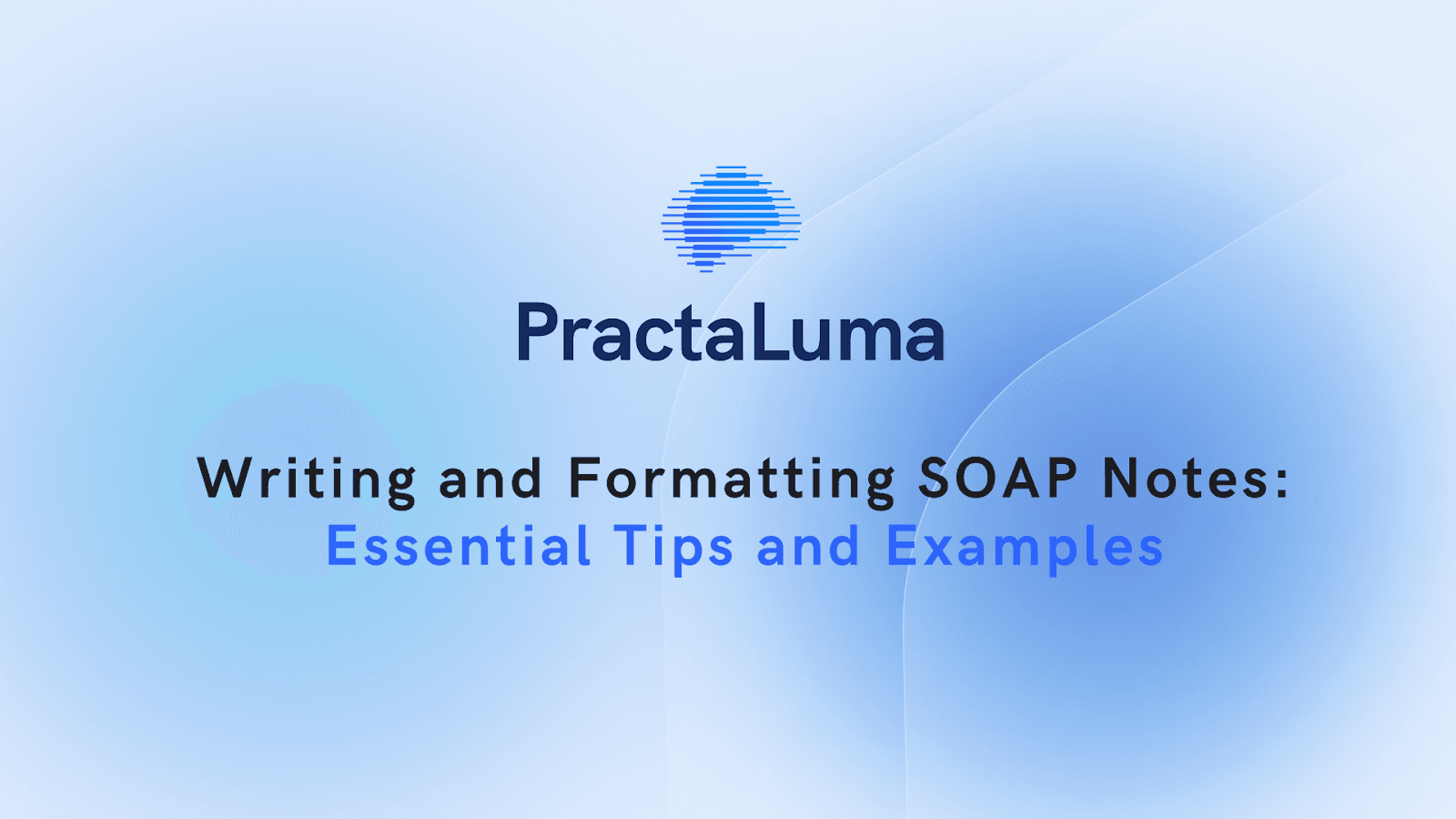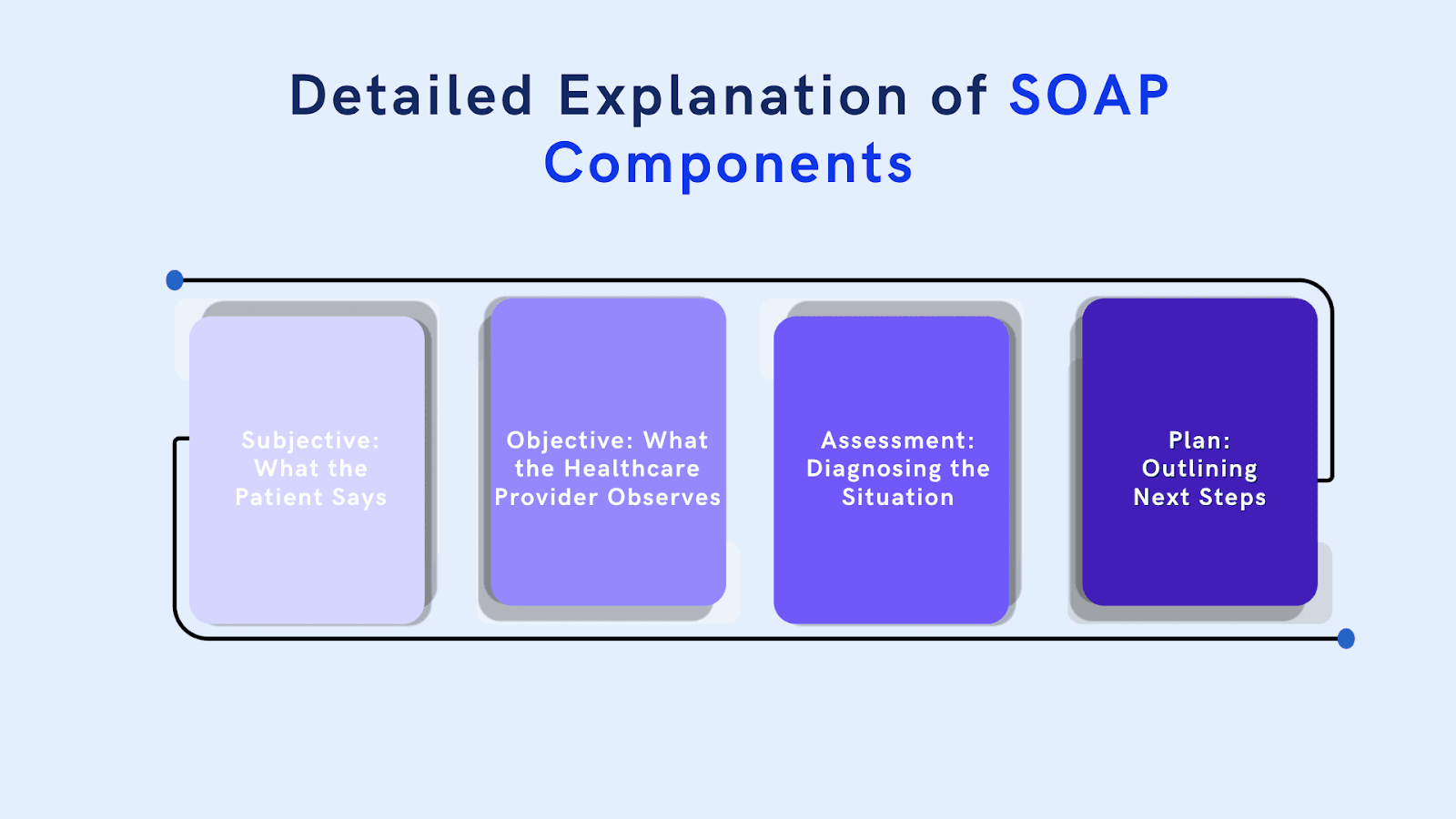
1 April 2025
Writing and Formatting SOAP Notes: Essential Tips and Examples
When it comes to healthcare documentation, clarity is crucial. One of the most effective ways to ensure clear, concise communication between healthcare providers is by using SOAP notes.
SOAP stands for Subjective, Objective, Assessment, and Plan and is a systematic method for recording patient information. This method is widely used in physical and mental health settings to ensure a consistent and effective way to track patient progress. Let us understand a SOAP note in detail!
What are SOAP Notes?
SOAP notes are a structured format for documenting patient information: Subjective (patient's experience), Objective (measurable data), Assessment (diagnosis), and Plan (next steps in care, treatment, and follow-up).
SOAP notes are structured to document patient encounters. Each section of the SOAP note allows healthcare providers to record different aspects of the patient’s condition, making it easier for others to understand the case at a glance.
Unlike narrative notes, which can be lengthy and more complex to review, SOAP notes offer a streamlined format that improves communication. Their standardised approach makes it easier to find critical information quickly, whether you’re looking at a patient's history, physical exam findings, or treatment plan. Let's explore the structure of practical SOAP notes.
Structure of a SOAP Note
Now that we understand what SOAP notes are and why they are essential, let’s look at the core structure of a SOAP note.
The Four Main Components: A SOAP note is divided into four distinct sections:
- Subjective: This is where the patient’s narrative comes in. It includes the main complaint, medical history, and symptoms as described by the patient.
- Objective: Here, you record observable and measurable data such as vital signs, lab results, or physical exam findings.
- Assessment: The assessment section synthesises the subjective and objective information to form a diagnosis or identify potential issues.
- Plan: This outlines the next steps in treatment, including medications, lifestyle recommendations, or follow-up appointments.
Standardised Format for Consistency: SOAP notes follow a clear, consistent format, making it easier for different healthcare providers to read and understand them. This consistency is vital in ensuring high-quality care and accurate record-keeping.
Enhancement of Communication: By breaking the information into standardised categories, SOAP notes help healthcare providers quickly understand the patient's condition, which is vital for timely decision-making. There are four distinct components of SOAP notes. Let’s explore each one in detail.
Detailed Explanation of SOAP Components

Now that we’ve established the structure of SOAP notes, let’s take a closer look at each section and what should be included.
1. Subjective: What the Patient Says
The Subjective section is all about the patient’s perspective. This is where you capture the patient's primary complaint, medical history, and direct quotes offering insight into their condition.
- Patient’s Main Complaint: Document the chief complaint (CC) in the patient’s own words. For example, “I’ve had a headache for the last three days.”
- Medical History: Include relevant medical history, such as previous diagnoses, surgeries, or treatments pertinent to the current visit.
- Direct Quotes: Where possible, include direct quotes to reflect the patient’s experience better. For instance, “I can’t sleep because of the pain” offers a more precise picture than saying, “The patient has pain.”
2. Objective: What the Healthcare Provider Observes
The Objective section involves documenting observable, measurable data, such as physical exam findings or test results.
- Vital Signs: Record blood pressure, heart rate, temperature, and respiratory rate.
- Physical Exam: Include findings such as abnormalities or average results during the examination.
- Test Results: Incorporate lab results or diagnostic test outcomes to give context to the subjective information provided by the patient.
3. Assessment: Diagnosing the Situation
In the Assessment section, you synthesise the subjective and objective data to diagnose or identify possible conditions. It helps other healthcare providers understand the clinical reasoning behind your decisions.
- Diagnosis: Based on the patient’s complaints and exam findings, you may arrive at a diagnosis (e.g., "Acute sinusitis").
- Differential Diagnosis: If the diagnosis is unclear, include a list of possible conditions that might explain the symptoms.
4. Plan: Outlining Next Steps
The Plan section details the next steps for patient care. You outline treatments, referrals, follow-up plans, and other vital instructions here.
- Treatment: Specify the medications, therapies, or procedures the patient will undergo.
- Follow-up: Note when the patient should return for follow-up visits or tests.
- Referrals: If necessary, refer the patient to a specialist for further evaluation or treatment. Let us look at some examples and tips for writing SOAP notes.
Examples and Tips for Writing SOAP Notes
Now that we’ve gone through the essential components, let's look at a few example scenarios and critical tips to improve your SOAP note-writing.
- General Practitioner: A patient comes in complaining of fatigue. The SOAP note will document the patient’s description of the fatigue, vital signs, possible causes (e.g., anaemia), and a treatment plan to check iron levels and recommend dietary changes.
This is how a SOAP Note would look,
- S (Subjective): Patient reports feeling fatigued for the past two weeks and describes tiredness throughout the day, particularly after meals. Denies shortness of breath or chest pain.
- O (Objective): Vital signs: BP 120/80, HR 78, Temp 98.6°F. No abnormal physical findings.
- A (Assessment): Fatigue likely due to possible anaemia. Further evaluation is needed.
- P (Plan): Order iron studies to check for anaemia. Recommend dietary changes, including iron-rich foods. Follow up in one week with lab results.
Let's consider another example in a mental healthcare context and write a SOAP Note accordingly.
- Mental Health Professional: A patient with anxiety may feel “overwhelmed” in the Subjective section. Objective data could include observed behaviours (e.g., restlessness), and the Assessment might diagnose generalised anxiety disorder (GAD) with a plan for therapy and medication.
This is how a SOAP Note would look,
- S (Subjective): Patient reports feeling “overwhelmed” with daily tasks and constant worry. Describes frequent restlessness, racing thoughts, and difficulty relaxing. Reports trouble sleeping and a sense of impending doom.
- O (Objective): Observed restlessness and fidgeting during the session. Tension noted in posture. No signs of delusional thinking or psychosis.
- A (Assessment): Generalized Anxiety Disorder (GAD) was diagnosed based on reported symptoms of excessive worry, restlessness, and sleep disturbances.
- P (Plan): Begin Cognitive Behavioral Therapy (CBT) for anxiety management. Prescribe an SSRI (Selective Serotonin Reuptake Inhibitor) for symptom relief. Follow-up in 2 weeks to assess progress and medication effectiveness.
Keep in mind,
- The Importance of Clarity: Be clear and concise. Avoid jargon or unnecessary details. The goal is for someone unfamiliar with the patient’s case to understand the core issue quickly.
- Conciseness and Relevance: Every detail in the SOAP note should be relevant. Avoid lengthy descriptions of irrelevant medical history or excessive information that might distract from the main issue.
Best Practices for Effective SOAP Documentation
Writing SOAP notes is a skill; practice makes perfect, like any skill. Here are some best practices to keep in mind:
- Goal-Oriented Planning: Every plan should be actionable. If you decide on a treatment, ensure it is measurable and has a precise follow-up.
- Avoid Vagueness: Be specific. Instead of saying, “The patient feels better,” mention how the patient feels or how symptoms have changed. For example, “The patient reports reduced pain from 8/10 to 4/10 after taking medication.”
- Clarity and Precision: Use simple, direct language. Avoid ambiguity or vague descriptions. The more precise your notes, the more helpful they’ll be.
Importance of Digital Tools and Templates
In today’s fast-paced healthcare environment, digital tools and templates have become invaluable for enhancing SOAP note documentation.
- Benefits of Digital Tools: Digital platforms allow healthcare professionals to enter data more quickly and accurately, improving efficiency and patient safety.
- Automated Tools: With automation, many digital platforms offer features like pre-filled fields or automatic reminders, helping providers complete SOAP notes quickly.
- Using Templates for Consistency: Standardised templates, like those available on Practaluma, ensure that all necessary information is included. Templates also maintain uniformity across all patient records, which is vital for long-term patient care.
Applications of SOAP Notes
SOAP notes are used across a wide range of medical disciplines. Here are just a few examples:
- Mental and Physical Health: SOAP notes are essential in both mental health and physical health settings for maintaining consistent, high-quality documentation.
- Legal and Ethical Compliance: SOAP notes can be crucial documentation in legal and insurance claims, providing a detailed patient care record.
- Insurance and Legal Purposes: In some cases, SOAP notes may be required as evidence in legal proceedings. Their straightforward, structured format makes tracking the patient’s progress and treatment accessible.
FAQs
1. What is the primary purpose of SOAP notes in healthcare?
A: SOAP notes are a standardised documentation method healthcare providers use to record patient information systematically. They enhance communication, improve patient care, and ensure consistency in medical records, which is vital for accurate decision-making and legal compliance.
2. How do SOAP notes differ from other documentation methods?
A: Unlike narrative notes, which can be lengthy and inconsistent, SOAP notes break down patient information into four key sections (Subjective, Objective, Assessment, and Plan). This structure makes it easier to review and understand the information quickly, promoting better continuity of care.
3. Why is the Subjective section important in SOAP notes?
A: The Subjective section captures the patient's words regarding their primary complaint, symptoms, and relevant medical history. It provides valuable insight into the patient's experience, essential for an accurate diagnosis and treatment plan.
4. How can SOAP notes be applied in mental health care?
A: SOAP notes are widely used in mental health settings to track patient progress, document symptoms, and monitor treatment effectiveness. The structured format helps mental health professionals record patient behaviour, mood, and therapy outcomes efficiently.
5. What are the benefits of using digital tools for SOAP note documentation?
A: Digital tools streamline the SOAP note process by automating data entry, reducing human error, and improving efficiency. Tools like Practaluma provide customisable templates, ensuring consistency and allowing healthcare providers to focus more on patient care and less on paperwork.
Conclusion
SOAP notes are an essential tool in healthcare documentation, offering a standardised method for recording patient information that enhances communication and improves patient care. By structuring patient encounters into the Subjective, Objective, Assessment, and Plan components, SOAP notes allow healthcare providers to document patient information clearly and concisely. Whether you're a physician, nurse, or mental health professional, mastering the art of SOAP note writing is crucial for effective clinical practice.
With digital tools and templates like those offered by Practaluma, healthcare professionals can streamline their documentation process, improve accuracy, and ensure consistency across all patient records.